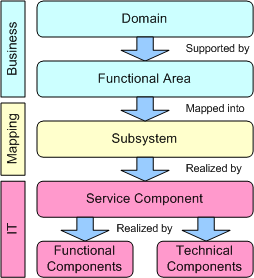Subsystems, in and of themselves, are not IT assets and not deployable into the IT infrastructure; they provide a
bridge between the business and IT perspectives. Each subsystem is realized by one or more Service Components where
a Service Component is an enterprise-scale asset (a managed software element with guaranteed availability, load
balancing, security, performance, and versioning). The Service Component is in turn realized by multiple Functional and
Technical Components according to the diagram below.

Generally each service assigned to a Subsystem will result in a Service Component; Functional and Technical Components
may be shared between Service Components within the same subsystem.
|

